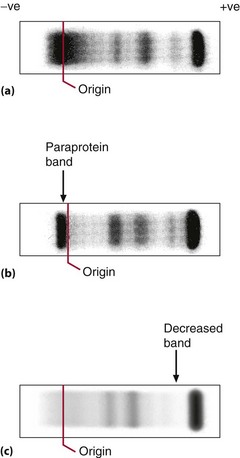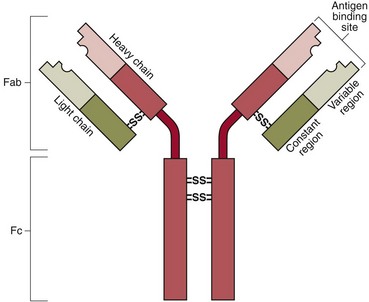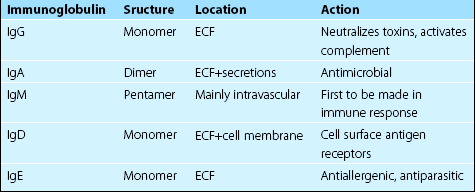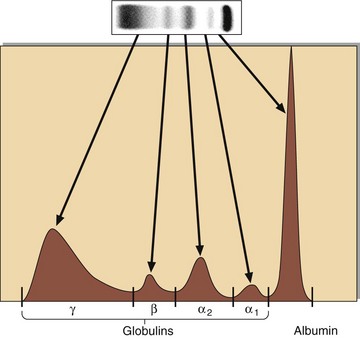26 All immunoglobulins have the same basic structure and consist of two identical ‘light’ and two identical ‘heavy’ polypeptide chains, held together by disulphide bridges (Fig 26.1). The light chains may be either of two types: kappa or lambda. The heavy chains may be of five types: alpha, gamma, delta, epsilon and mu. The immunoglobulins are named after their heavy chain type, as IgA, IgG, IgD, IgE and IgM. The molecules are characterized by two functional areas: The various classes of immunoglobulins have different tertiary structure and functions (Table 26.1). The major antibodies in the plasma are IgG, IgA and IgM. Electrophoresis may be carried out to study a number of protein abnormalities. The normal pattern is shown in Figure 26.2(a). Immunoglobulins are detected primarily in the gamma globulin area on electrophoresis. Electrophoresis can show gross deficiency or excess of immunoglobulins and the presence of discrete bands (paraproteins) (Fig 26.2, b and c). Serum should be used for electrophoresis, as the fibrinogen of plasma (consumed during clotting) gives a discrete band that can easily be mistaken for a paraprotein. A quantitative measure of each protein class may be obtained by scanning the electrophoresis strip (Fig 26.3). Fig 26.2 Electrophoresis of serum proteins. (a) Normal pattern; (b) paraprotein band; (c) α1-antitrypsin deficiency.
Immunoglobulins
Structure
 The Fab, or variable end is the area that recognizes and binds to the antigen.
The Fab, or variable end is the area that recognizes and binds to the antigen.
 The Fc end is responsible for interaction with other components of the immune system, e.g. complement and T-helper cells.
The Fc end is responsible for interaction with other components of the immune system, e.g. complement and T-helper cells.
Electrophoresis of serum proteins

Basicmedical Key
Fastest Basicmedical Insight Engine






